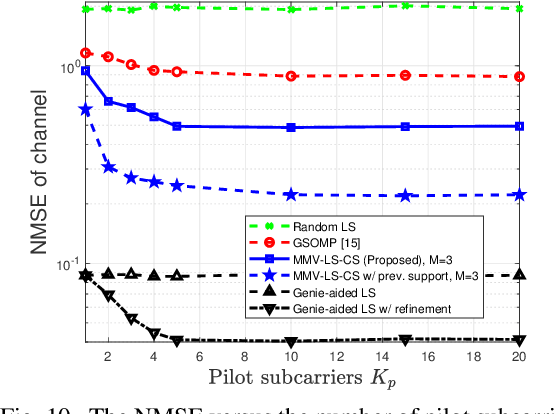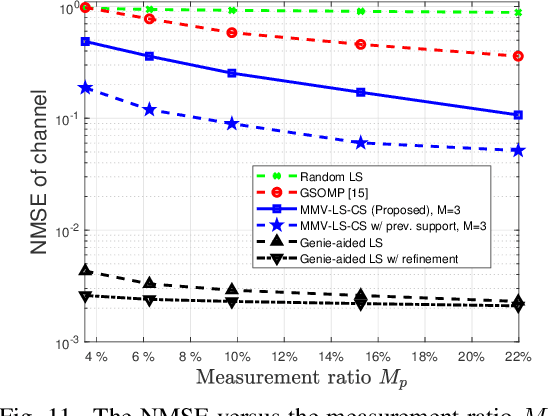Tzu-Hsuan Chou
Joint UAV Placement and Transceiver Design in Multi-User Wireless Relay Networks
Jul 16, 2025Abstract:In this paper, a novel approach is proposed to improve the minimum signal-to-interference-plus-noise-ratio (SINR) among users in non-orthogonal multi-user wireless relay networks, by optimizing the placement of unmanned aerial vehicle (UAV) relays, relay beamforming, and receive combining. The design is separated into two problems: beamforming-aware UAV placement optimization and transceiver design for minimum SINR maximization. A significant challenge in beamforming-aware UAV placement optimization is the lack of instantaneous channel state information (CSI) prior to deploying UAV relays, making it difficult to derive the beamforming SINR in non-orthogonal multi-user transmission. To address this issue, an approximation of the expected beamforming SINR is derived using the narrow beam property of a massive MIMO base station. Based on this, a UAV placement algorithm is proposed to provide UAV positions that improve the minimum expected beamforming SINR among users, using a difference-of-convex framework. Subsequently, after deploying the UAV relays to the optimized positions, and with estimated CSI available, a joint relay beamforming and receive combining (JRBC) algorithm is proposed to optimize the transceiver to improve the minimum beamforming SINR among users, using a block-coordinate descent approach. Numerical results show that the UAV placement algorithm combined with the JRBC algorithm provides a 4.6 dB SINR improvement over state-of-the-art schemes.
Hybrid Fingerprint-based Positioning in Cell-Free Massive MIMO Systems
Feb 04, 2025



Abstract:Recently, there has been an increasing interest in 6G technology for integrated sensing and communications, where positioning stands out as a key application. In the realm of 6G, cell-free massive multiple-input multiple-output (MIMO) systems, featuring distributed base stations equipped with a large number of antennas, present an abundant source of angle-of-arrival (AOA) information that could be exploited for positioning applications. In this paper we leverage this AOA information at the base stations using the multiple signal classification (MUSIC) algorithm, in conjunction with received signal strength (RSS) for positioning through Gaussian process regression (GPR). An AOA fingerprint database is constructed by capturing the angle data from multiple locations across the network area and is combined with RSS data from the same locations to form a hybrid fingerprint which is then used to train a GPR model employing a squared exponential kernel. The trained regression model is subsequently utilized to estimate the location of a user equipment. Simulations demonstrate that the GPR model with hybrid input achieves better positioning accuracy than traditional GPR models utilizing RSS-only and AOA-only inputs.
Dual-Wideband Time-Varying Sub-Terahertz Massive MIMO Systems: A Compressed Training Framework
Jan 04, 2022



Abstract:Designers of beyond-5G systems are planning to use new frequencies in the millimeter wave (mmWave) and sub-terahertz (sub-THz) bands to meet ever-increasing demand for wireless broadband access. Sub-THz communication, however, will come with many challenges of mmWave communication and new challenges associated with the wider bandwidths, larger numbers of antennas and harsher propagation characteristics. Notably the frequency- and spatial-wideband (dual-wideband) effects are significant at sub-THz. To address these challenges, this paper presents a compressed training framework to estimate the sub-THz time-varying MIMO-OFDM channels. A set of frequency-dependent array response matrices are constructed, enabling the channel recovery from multiple observations across subcarriers via multiple measurement vectors (MMV). Capitalizing on the temporal correlation, MMV least squares (MMV-LS) is designed to estimate the channel on the previous beam index support, followed by MMV compressed sensing (MMV-CS) on the residual signal to estimate the time-varying channel components. Furthermore, a channel refinement algorithm is proposed to estimate the path coefficients and time delays of the dominant paths. To reduce the computational complexity, a sequential search method using hierarchical codebooks is proposed for greedy beam selection. Numerical results show that MMV-LS-CS achieves a more accurate and robust channel estimation than state-of-the-art algorithms on time-varying dual-wideband MIMO-OFDM.
 Add to Chrome
Add to Chrome Add to Firefox
Add to Firefox Add to Edge
Add to Edge